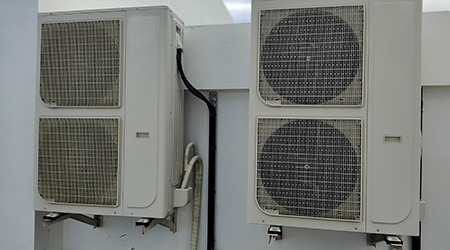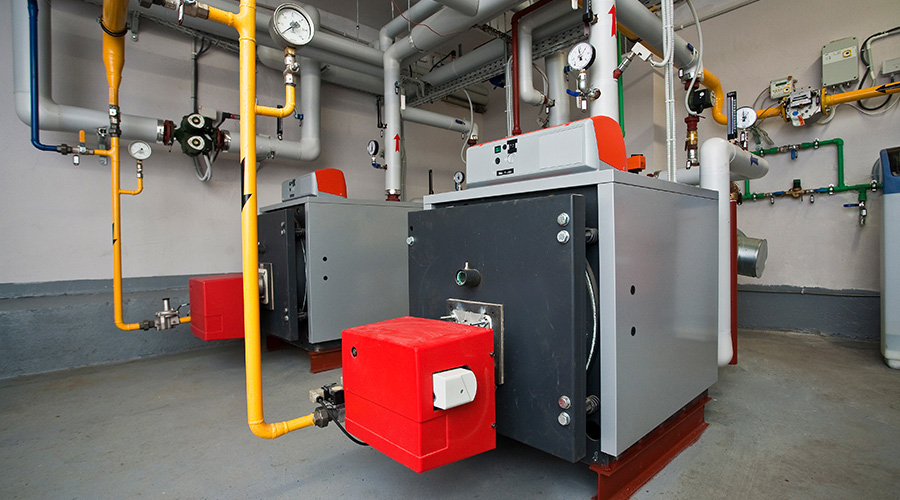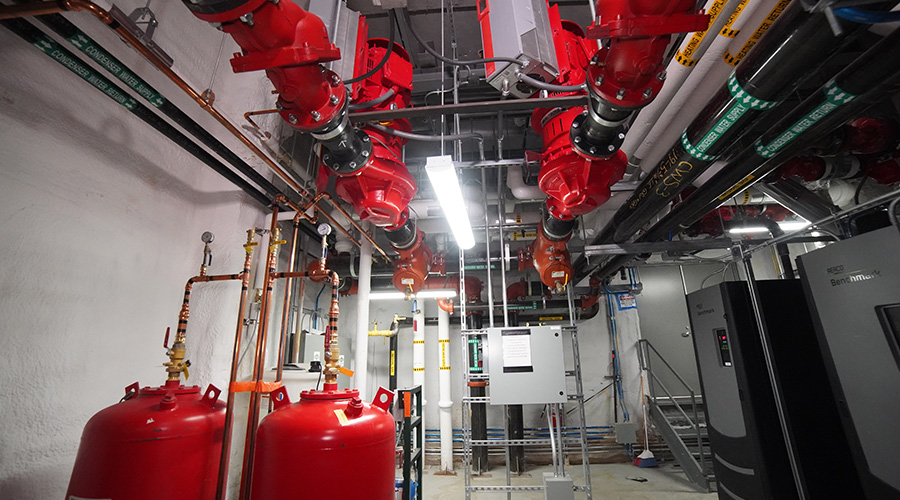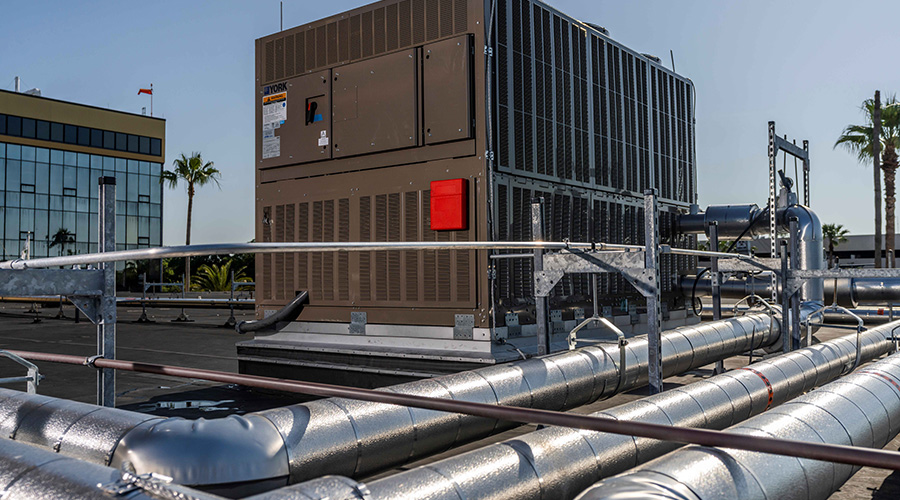Pandemic Shines Spotlight on VRF
The technology’s efficiency, installation flexibility and temperature control help managers meet facility demands of COVID-19 era.
For nearly two years since the onset of the COVID-19 pandemic, the topic of air quality has been top of mind for maintenance and engineering managers in institutional and commercial facilities.
As employees slowly return to the office, they are increasingly concerned with the quality of air in the buildings they occupy. One type of HVAC technology that has received considerable attention during the pandemic is variable refrigerant flow (VRF) systems.
VRF has steadily gained traction among managers attracted to the technology’s energy efficiency, installation flexibility, and temperature control capabilities, says Joe Cefaly, senior manager of applications with Mitsubishi Electric Trane HVAC US.
Monitoring zones
A VRF system serves as an energy-efficient, all-electric heating and cooling option that lets managers to reduce onsite carbon emissions and fossil-fuel combustion while providing comfort to occupants, Cefaly says. VRF systems also can help future-proof a building as carbon footprint standards and requirements continue to evolve.
A VRF system moves conditioned refrigerant through piping to zones requiring heating or cooling. A precise amount of energy is required to keep each interior zone at the desired temperature. VRF modulates capacity and energy use with an inverter compressor.
“Ramping up and down to maintain each zone’s set point is more efficient than cycling through starts and stops like conventional systems,” Cefaly says. “All-electric VRF systems are an increasingly popular heating and cooling technology for buildings looking to reduce or eliminate onsite fossil-fuel combustion and the resulting air pollution.”
Cefaly points to a study by researchers at the Harvard T.H. Chan School of Public Health that tracked cognitive scores for workers in an office space with conventional levels of volatile organic compounds (VOC) and pollutant exposure versus an office environment with low concentrations and low exposure to VOCs and pollutants.
“The 2016 study reported that cognitive scores were 61 percent higher when office workers experienced low concentrations of pollutants,” Cefaly says. “When the researchers increased the ventilation rate in the healthier space, cognitive scores increased 101 percent compared to the conventional baseline.”
The pandemic has affected many building systems, including HVAC, says Nick Agopian of RenewAire. Building operators encountered the massive challenge of part-load conditions in buildings.
“With less load, conventional systems tend to cycle on and off, causing undue stress on the rotating parts of the systems,” Agopian says. “Existing VRF installations have the luxury to modulate down and up as needed based on internal and external load requirements. This feature, coupled up with the ease of installation, has increased demand for VRF in today's environment.”
VRF is often used as a packaged approach with energy recovery ventilation. Increased ventilation packaged with VRF offers the ultimate result of good indoor air quality (IAQ) and indoor environmental comfort, Agopian says. This is accomplished with standard energy recovery ventilators or dedicated outdoor air systems (DOAS).
Having multiple indoor VRF units in various areas allows for multiple points of filtration. These micro-conditioning points enable the air to recirculate and filter more frequently.
“If you offer MERV 13 filtration, not only are you improving IAQ, but based on cognizant authorities, you can make the space healthier and safer against pathogens,” Agopian says. “In addition, high-efficiency treatment of air in micro-zones offers quicker filtration of contaminated air.”
When used in offices, schools, shopping centers, and manufacturing plants operating at less than peak, VRF offers the turndown capacity to maintain the temperature within the space.
“A conventional system that cycles on and off will create temperature swings that cause poor IEQ and discomfort for the occupant,” Agopian says.
Changing work spaces
VRF systems allow for on-demand comfort heating and cooling while providing the necessary airflow and air changes as prescribed in current industry standards, says CJ Corbet of Fujitsu General America.
“When used in conjunction with air-quality devices, such as mechanical and UV filtration and ionization, questions of health-related concerns can be alleviated,” Corbet says. “With workplaces changing to adapt to fewer in-building employees and occupants, installed VRF systems can vary their speed to account for the heating and cooling demand of a varying occupancy. As companies start to bring people back into their buildings, a VRF system can adapt to anything from the minimum to maximum occupant levels.”
As traditional work environments evolve and new COVID-19 variants emerge, VRF technology allows managers to provide individualized zone control based on building occupancy, user preference, and real-time heating and cooling loads.
“This results in better energy efficiency and comfort,” Cefaly says. “VRF systems excel at maintaining the thermal comfort marketable buildings need to foster productivity and wellness while also improving sustainability. As workspaces change due to trends like remote work, VRF technology allows for flexibility in reconfiguring or tweaking a system to meet new tenant requirements.”
VRF is a viable option in both new construction and retrofit applications. The variety of indoor unit types allows for applications in any environment that typically uses comfort heating and cooling, Corbet says. Ductless units allow for applications where attic or in-wall space is minimal or non-existent. Ducted units allow for retrofitting unitary equipment while using existing ductwork where applicable. With the large number of indoor units allowed on one system, the combinations and applications of VRF are extensive.
VRF systems work in retrofit applications because the systems can be installed while maintaining the integrity and historic character of a building, Cefaly says.
From a maintenance standpoint, VRF systems often are easier to maintain than typical chiller and boiler central plant systems. And a variety of remote controllers and other devices are available to satisfy the level of tenant control on a zone-by-zone basis while providing comfort control for building occupants.
If a tenant varies space layouts, VRF technology offers flexible designs to accommodate last-minute changes in capital projects and retrofits. One advantage with VRF is that managers can phase in the installation for retrofits.
“It’s modular construction strategy,” Agopian says. “Conventional systems cannot do that.”
Specification needs are often variable. Like other technologies in the market, VRF can be single-phase or three-phase power, ducted or unducted, or floor- or ceiling-mounted.
Agopian says the most critical specification parameter is load reduction.
“Refrigerant is a high concentrate of energy transfer, offering lower losses as you transport it around the built environment,” he says.
Rather than transfer energy from the compressor to the refrigerant to the coil to air and then take the air to the space, VRF systems take the refrigerant to the space.
“Building conversions like an office to residential allows for changing indoor units while maintaining the more expensive outdoor units. VRF with compact ducting or unducted systems is much more retrofittable than central systems,” Agopian says.
Conversely, in retrofit applications using larger centralized systems, managers must take down the whole building, while VRF applications allow them to only turn off sections of the building. VRF also technology takes up less space, offering volumetric space savings and potentially increases usable and rentable space for more revenue potential.
Looking ahead
VRF systems remain popular options because they offer full-range variable capacity to deliver the amount of conditioning needed to fulfill a zone’s demand.
“A new hybrid VRF option is also emerging in the U.S. market,” Cefaly says. “Already popular in parts of Asia and Europe, hybrid VRF systems are a two-pipe heat-recovery VRF technology with a unique hybrid branch controller designed to use water as the heat-transfer medium in occupied spaces.”
The systems circulate refrigerant between the outdoor unit and the hybrid branch controller. Indoor units are connected to this controller via water pipes so the system can supply heating or cooling to the conditioned space via water, not refrigerant.
“Market demand for multi-function systems is growing, and VRF caters to these new market needs,” Agopian says. “VRF has grown faster than conventional systems, and VRF rate of growth is faster than traditional systems as adoption and education grow.”
The biggest HVAC technology change in the near future will relate to refrigerant, Corbet says. With technology advances, concerns about ozone depletion and global warming potential come into play. Refrigerants that can minimize the impact on the environment are becoming preferred alternatives to older versions.
“VRF evolution has also changed for the better in energy efficiency, bringing in smaller and larger unit sizes and allowing seamless connections with outside systems,” Corbet says.
Maura Keller is a freelance writer based in Minneapolis, Minnesota.
Related Topics:












